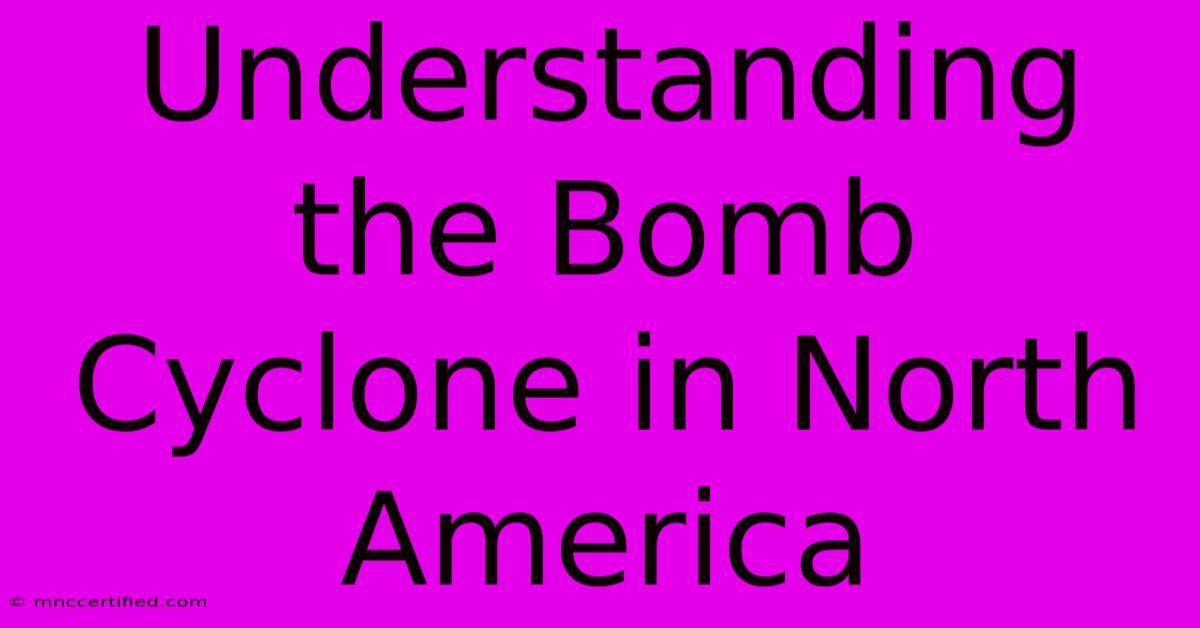Understanding The Bomb Cyclone In North America

Table of Contents
Understanding the Bomb Cyclone in North America: A Deep Dive into Intense Winter Storms
The term "bomb cyclone" conjures images of intense winter storms, blizzards, and widespread disruption. But what exactly is a bomb cyclone, and why are they so dangerous? This comprehensive guide will unravel the meteorology behind these powerful weather systems and explain their impact on North America.
What is a Bomb Cyclone?
A bomb cyclone, also known as bombogenesis, is a mid-latitude cyclone that intensifies rapidly. This rapid intensification is defined by a drop in central atmospheric pressure of at least 24 millibars in 24 hours. This pressure drop is significant, leading to a dramatic increase in the storm's wind speeds and the potential for severe weather. The term itself is somewhat dramatic, but it accurately reflects the explosive nature of these storms.
How Does Bombogenesis Occur?
Bomb cyclones form when several atmospheric conditions align:
- Cold air mass: A large pool of frigid arctic air is crucial. This cold air provides the necessary temperature contrast for the storm's development.
- Warm air mass: A relatively warm air mass, often originating from the ocean, interacts with the cold air mass. This contrast in temperature fuels the storm's energy.
- Atmospheric instability: A significant difference in air temperature and pressure creates instability in the atmosphere, driving rapid upward motion of air. This leads to the formation of intense low-pressure systems.
- Upper-level support: The jet stream, a high-altitude river of fast-moving air, plays a vital role. A strong and favorable jet stream pattern can enhance the development of the cyclone by providing lift and focusing the energy.
These factors combine to create a feedback loop, where the storm's intensification further enhances the processes leading to more intensification – a classic example of positive feedback in meteorology.
The Impact of Bomb Cyclones on North America
Bomb cyclones can have devastating consequences across North America:
- Heavy snowfall: Intense snowfall rates can lead to blizzard conditions, crippling transportation and causing widespread power outages. Many regions experience significant accumulation in a short period, making travel extremely dangerous.
- High winds: The rapid pressure drop associated with bombogenesis creates powerful winds, potentially exceeding hurricane force. These winds can cause significant damage to structures, uproot trees, and lead to coastal flooding.
- Coastal flooding: The combination of high winds and storm surge can lead to severe coastal flooding, particularly in low-lying areas. This can inundate coastal communities and cause extensive damage to property.
- Extreme cold: The cold air associated with these storms can lead to dangerously low temperatures, posing risks to human health and infrastructure. Frozen pipes and hypothermia are significant concerns.
Predicting and Preparing for Bomb Cyclones
Accurate prediction of bomb cyclones is crucial for minimizing their impact. Meteorological agencies utilize sophisticated weather models and satellite imagery to monitor atmospheric conditions and issue timely warnings. Preparation is key:
- Stay informed: Monitor weather forecasts regularly and heed warnings from official sources.
- Prepare your home: Stock up on essential supplies, including food, water, and medications.
- Secure your property: Bring loose objects inside to prevent damage from high winds.
- Develop an evacuation plan: If you live in a coastal area or other vulnerable location, have a plan in place to evacuate if necessary.
Key Differences Between Bomb Cyclones and Other Storms
While bomb cyclones are intense, it's important to understand their differences from other weather events:
- Hurricanes: Bomb cyclones are extratropical cyclones, meaning they form outside the tropics. Hurricanes are tropical cyclones, forming over warm ocean waters.
- Blizzards: A blizzard is a specific type of severe winter storm characterized by heavy snow, strong winds, and low visibility. A bomb cyclone can cause a blizzard, but not all bomb cyclones result in blizzards.
Conclusion: Understanding the Power of Nature
Bomb cyclones are potent weather systems capable of inflicting significant damage and disruption across North America. Understanding their formation, impact, and the importance of preparedness is essential for mitigating their effects and ensuring safety during these powerful storms. By staying informed and taking proactive steps, individuals and communities can significantly reduce their vulnerability to the destructive power of bombogenesis.

Thank you for visiting our website wich cover about Understanding The Bomb Cyclone In North America. We hope the information provided has been useful to you. Feel free to contact us if you have any questions or need further assistance. See you next time and dont miss to bookmark.
Featured Posts
-
Eternity Coins And Collectibles
Nov 23, 2024
-
How To Fix Ticking Block Entity
Nov 23, 2024
-
Championship Match Plymouth Watford Live
Nov 23, 2024
-
Ariana Cynthia Tears In Wicked Film
Nov 23, 2024
-
Gun Deer Season Missing Person
Nov 23, 2024